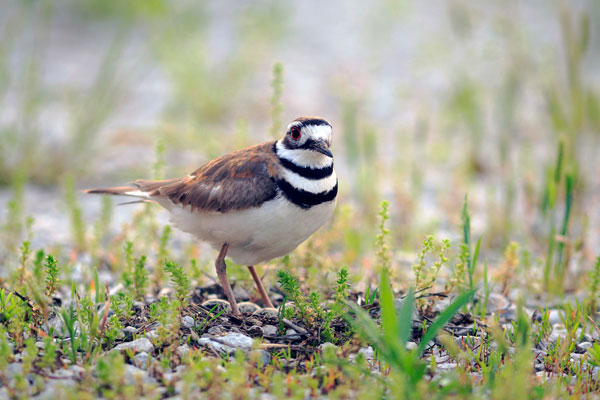
By Dan Zarlenga, Missouri Department of Conservation
Photo Caption: What’s this killdeer up to? It could launch into an elaborate deception at any minute. Photo by Dan Zarlenga
Some creatures in nature are just plain deceptive. The killdeer is one of those types.
Killdeers are birds that belong to the group of shorebirds called plovers. Like most shorebirds, killdeer have long, skinny legs. The adults are dark brown above and white below and are about 10 inches long. What stands out about them are the two black bands on the breasts and the white streak above their eyes. They also have very long, thin, pointed bills.
Killdeer get their name from the call they make—high-pitched, shrill, and stuttering—which is often described as sounding like the bird is saying “kill-deer, kill-deer”. That’s their first deception—they don’t even kill deer! Killdeer mostly eat insects really, but they can also be predators of small clams and other invertebrates too.
That brings us to the next thing that killdeer are not totally honest about. They are supposed to be shorebirds, yet much of the time when you find them . . . there’s no shore to be seen! In fact, killdeer often inhabit fields and other arid uplands. They prefer open, flat, dry areas where grass is very short. Kildeer may forage or nest in and around flooded fields, golf courses, lawns, sports fields, or muddy shorelines. But you’re just as likely to find them in a gravel parking lot, industrial parks, or nesting on a flat, gravel rooftop for that matter. So, it seems they frequently don’t live up to their names as “shorebirds” either.
Speaking of nesting, killdeer will play another trick on you! Females create their nests by scratching shallow depressions into the ground. They are quite simple structures, except the female will often decorate the nest spots with rocks and other objects. The mother lays a clutch of three to six eggs, which have brown and black speckles to help camouflage them. It’s at this time killdeer can be at their most deceptive.
Sometimes, a killdeer will fly away from the nest, then land on the ground some distance away. The bird emits a plaintive distress call as it flails on the ground shaking its wing “in pain”. The bird flashes the bright orange underside of the wing to draw you, and a would-be predator, to it. Then as you approach for a look, or the predator tempted by an easy bite, the killdeer is suddenly “healed” and flies up again, only to lure you even farther from the nest! It’s called the “broken wing” trick, and it’s a sneaky ruse to be certain. But one that helps ensure the survival of its young.
As motives for deception are concerned, one must admit this is probably among the most noble. So perhaps we can forgive the killdeer for this bit of bait and switch, as we marvel at nature’s amazing adaptations for survival.


